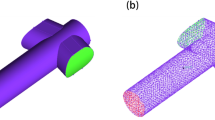Abstract
This paper discussed whether the pouring basin geometry with asymmetric configuration could significantly reduce the porosity defects of an Al-Si7Mg(Fe) alloy (AC4C) castings and whether it could be used for the production of scroll compressors in large quantities according to computer-aided numerical (CAE) method and experiments. The molten aluminum alloy's filling forms were simulated to contrast the molten flow feature of the melt aluminum, which was poured from the typical pouring basin geometry and the proposed counterpart. The CAE simulation shows that the initially symmetric pouring basin causes the molten aluminum to fill at an uneven rate. It is comparatively filled at a relatively smooth filling form in the proposed asymmetric configuration of the pouring basin. The proposed pouring basin geometry resulted in an 85% less porosity percentage. It's concluding that the designed asymmetric pouring basin could be applied in the tilt casting process. By adjusting the geometric feature of outlet shape, different pouring cup volume distribution ratios can effectively reduce the casting defects of a mass-produced scroll compressor.









Similar content being viewed by others
References
K.L. Fan et al., Elevated temperature low cycle fatigue of a gravity casting Al-Si-Cu alloy used for engine cylinder heads. Mater. Sci. Eng., A 632, 127–136 (2015)
J. Zheng, B. Huang, X. Zhou, A low carbon process design method of sand casting based on process design parameters. J. Clean. Prod. 197, 1408–1422 (2018)
J. Mi, R.A. Harding, J. Campbell, The tilt casting process. Int. J. Cast Met. Res. 14(6), 325–334 (2002)
Su. Qin Xin-yu, C.J. Yong et al., Finite element analysis for die casting parameters in high-pressure die casting process. China Foundry 16(4), 272–276 (2019)
Durville P.H.G. Brit patent GB191323719; 1913.
T.R. Vijayaram et al., Numerical simulation of casting solidification in permanent metallic molds. J. Mater. Process. Technol. 178, 29–33 (2006)
J. Sun, Q. Le, L. Fu, J. Bai, J. Tretter, K. Herbold, H. Huo, Gas entrainment behavior of aluminum alloy engine crankcases during the low-pressure-die-casting process. J. Mater. Process. Technol. 266, 274–282 (2019)
J. Choi, H. Hwang, S. Kang, Effect of ladle outlet geometry on internal porosity in gravity casting automotive brackets: an experimental investigation. China Foundry 17(1), 56–60 (2020)
H. Wang, G. Djambazov, K.A. Pericleous, R.A. Harding, M. Wickins, Modelling the dynamics of the tilt-casting process and the effect of the mold design on the casting quality. Comput. Fluids 42(1), 92–101 (2011)
J. Major, M. Hartlieb, Advances in aluminum foundry alloys for permanent and semi-permanent mold casting. Inter Metalcast 3, 43–53 (2009). https://doi.org/10.1007/BF03355452
P. Ashtari, G. Birsan, A. Khalaf et al., Controlled diffusion solidification of 2024, 6082 and 7075 Al alloys via tilt-pour casting process. Inter Metalcast 5, 43–64 (2011). https://doi.org/10.1007/BF03355471
E. Kilinc, N. Kiremitci, Y. Birol et al., Effect of vanadium and zirconium additions on mechanical properties and microstructure of gravity die-cast AlSi9Cu2 alloy cylinder heads. Inter Metalcast 13, 137–145 (2019). https://doi.org/10.1007/s40962-018-0238-z
E. Kilinc, S. Akbalik, Y. Birol, Optimization of the strontium modification process in gravity permanent mould tilt cast AlSi6Cu4 cylinder heads. Inter Metalcast 12, 266–274 (2018). https://doi.org/10.1007/s40962-017-0158-3
S.H. Majidi, C. Beckermann, Effect of pouring conditions and gating system design on air entrainment during mold filling. Inter Metalcast 13, 255–272 (2019). https://doi.org/10.1007/s40962-018-0272-x
Acknowledgements
The authors gratefully acknowledge the financial support provided by the Bureau of Energy, Ministry of Economic Affairs, Taiwan, R. O. C. and Hanbell Precise Machinery Co. Ltd.(10813033).
Author information
Authors and Affiliations
Corresponding author
Additional information
Publisher's Note
Springer Nature remains neutral with regard to jurisdictional claims in published maps and institutional affiliations.
Supplementary Information
Below is the link to the electronic supplementary material.



Rights and permissions
About this article
Cite this article
Kao, Y.C., Tseng, HW., Ho, MH. et al. Prediction of the Effect of Asymmetric Pouring Basin Geometry on Temperature, Internal Porosity in Tilt Casting Housing of Scroll Compressor. Inter Metalcast 16, 613–621 (2022). https://doi.org/10.1007/s40962-021-00659-8
Received:
Accepted:
Published:
Issue Date:
DOI: https://doi.org/10.1007/s40962-021-00659-8




